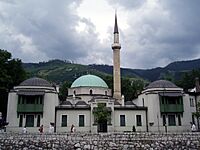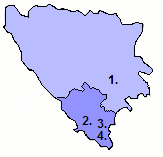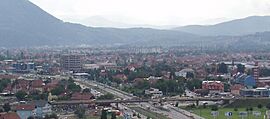Bosnian uprising (1831–1832) facts for kids
Quick facts for kids Great Bosnian uprising |
|||||||||
|---|---|---|---|---|---|---|---|---|---|
| Part of the anti-reformist movement in the Ottoman Empire | |||||||||
|
|||||||||
| Belligerents | |||||||||
| Commanders and leaders | |||||||||
| Strength | |||||||||
| Casualties and losses | |||||||||
The Bosnian Uprising was a major rebellion by local Bosnian leaders, called ayans, against the ruler of the Ottoman Empire, Sultan Mahmud II. The main reason for the uprising was that the Sultan wanted to make big changes and get rid of the ayan system.
Even though the rebels won some important battles, they were eventually defeated near Sarajevo in 1832. The rebellion failed partly because not all Bosnian leaders supported their main leader, Husein Gradaščević.
After the uprising, Ali Pasha Rizvanbegović was made the new governor (called a pasha) of Herzegovina, which became separate in 1833. The Sultan changed the old ayan system. Later, in 1850, another pasha named Omer Pasha completely removed the old ayan families from power.
Contents
Why Did the Uprising Happen?
Sultan Mahmud II wanted to make the Ottoman Empire stronger and more modern. He aimed to have more control from the central government. He started by getting rid of the old Spahi system and the Janissaries, who were special soldiers.
His goal was to change the empire from a religious state (a Theocracy) into a constitutional monarchy. This meant everyone would be equal under the law, no matter their background. They would also have the same duties to the state.

However, the Bosnian ayans and the Janissaries in Bosnia didn't like these changes. They wanted to keep their special rights and money from taxes. They also didn't want to send their men to the Sultan's army. They preferred things to stay the same.
The reforms meant they would lose their power and independence. The Bosnian ayans were also very traditional in their religious beliefs. They saw the Sultan's reforms as "unfaithful" because they copied European ideas. They believed these changes threatened their Islamic faith. The ayans thought that Ottoman rule and Islam could only last if they kept their power.
Janissaries Rebel in Sarajevo
The first attempts to bring reforms to Bosnia began in 1826. Sultan Mahmud II created a new army called the Nizam and officially ended the Janissary units across the empire. But the Bosnian ayans protected the Janissaries and refused to follow the Sultan's order.
In Sarajevo, the Janissaries rebelled on July 20, 1826. They gathered near the Emperor's Mosque and chose their own leader, Ali Agha Ruščuklija. They even asked the Sultan to let them keep their unit in Bosnia.
The Ottoman governor (vizier) in Bosnia, Mustafa Pasha Belenlija, was fired because he couldn't control the situation. Abdurahman Pasha replaced him in December 1826. The new vizier had to stay in Zvornik because the Janissaries controlled Sarajevo. Many Bosnian ayans were unhappy with the new vizier.
Many Bosnian Muslims believed that the military reforms would lead to the collapse of the Ottoman Empire. They feared that European Christians would then persecute them. They also worried the Sultan would punish them by sending them to war against Russia. They thought Serbia, an ally of Russia, might take their lands.
Abdurahman Pasha was ordered to stop the Janissary revolt, which had a lot of support. In February 1827, the Ottoman army, led by Ali Pasha Vidajić, finally defeated the Janissaries. Many ayans who had promised help to the Janissaries never sent it. Most ayans stayed neutral, but some, like Husein Gradaščević, supported the vizier.
After their defeat, Abdurahman Pasha ordered the execution of several leaders who supported the Janissaries. About 300 local leaders (beys) were imprisoned. By March 1827, Abdurahman Pasha controlled all of Bosnia. He removed all opposition to the military reform.
However, the Bosnian ayans were not united. Some, especially in Herzegovina, supported the Sultan. Gradaščević became the leader of those who opposed the reforms. But Ali Pasha Rizvanbegović, Smail Agha Čengić, and Hasan Bey Resulbegović led those who supported the Sultan.
In 1830, ayans from the Posavina region met in Tuzla. They decided to rebel against the reforms. They were especially upset because the Ottoman government gave some of their land to Serbia. They felt the government wasn't protecting them enough.
The Uprising Begins
The Tuzla meeting led to another big meeting planned for Travnik. Travnik was where the Bosnian governor lived, so this meeting was a direct challenge to the Ottoman government. Gradaščević asked everyone to gather an army before the meeting.
On March 29, 1831, Gradaščević marched towards Travnik with about 4,000 men.
When the governor, Namik-paša, heard about the approaching army, he went to the Travnik fort. He called for help from the Sulejmanpašić brothers. When Gradaščević's army arrived, they fired warning shots at the castle. This showed they were ready to fight.
Gradaščević sent a part of his army, led by Memiš-aga of Srebrenica, to stop the Sulejmanpašić brothers' reinforcements. The two sides met at Pirot on April 7. Memiš-aga defeated the Sulejmanpašić brothers and their 2,000-man army. They were forced to retreat.
On May 21, Namik-paša fled to Stolac after a short siege. Soon after, Gradaščević declared himself the "Commander of Bosnia, chosen by the will of the people."
On May 31, Gradaščević asked all noble families and anyone else who wanted to, to join his army. Thousands joined him, including many Christians, who made up about a third of his forces. Gradaščević split his army. He left one part in Zvornik to guard against a possible attack from Serbia.
With the main part of his army, he headed towards Kosovo. He planned to meet the Grand Vizier, who was coming with a large army to stop the rebellion. Along the way, Gradaščević captured the cities of İpek and Priştine, where he set up his main camp.
The battle with Grand Vizier Mehmed Rashid-paša happened on July 18 near Shtime. Both armies were about the same size, but the Grand Vizier's troops had better weapons. Gradaščević sent part of his army, led by Ali-beg Fidahić, forward. Fidahić pretended to retreat.
Thinking he had won, the Grand Vizier foolishly sent his cavalry and cannons into a forest. Gradaščević quickly used this mistake. He launched a strong counterattack with most of his forces. He almost completely destroyed the Ottoman army. Rashid-paša himself was hurt and barely escaped.
A Rebel Government in Bosnia
After the battle, the Grand Vizier claimed the Sultan would agree to all Bosnian demands if the rebel army returned home. So, Gradaščević and his army turned back. On August 10, a meeting of all important leaders of the movement was held in Priştine. At this meeting, they decided that Gradaščević should be declared the governor (vizier) of Bosnia.
Gradaščević first refused, but his supporters insisted, and he finally accepted. His new position became official at a big Bosnian meeting in Sarajevo on September 12. In front of the Emperor's Mosque, everyone swore on the Qur'an to be loyal to Gradaščević. They declared there would be no turning back, even if it meant failure or death.
At this point, Gradaščević was not only the top military commander but also Bosnia's main civilian leader. He set up a court around him. After staying in Sarajevo for a short time, he moved the center of Bosnian politics to Travnik. This made Travnik the unofficial capital of the rebel state.
In Travnik, he created a Divan, which was like a Bosnian congress. This Divan, along with Gradaščević, formed the Bosnian government. Gradaščević also collected taxes and punished local people who opposed the movement. He became known as a hero and a strong, brave, and decisive ruler.
Opposition in Herzegovina
During this time of peace with the Ottomans, attention turned to the strong opposition in Herzegovina. A small military campaign was launched against the region from three different directions:
- An army from Sarajevo was ordered to attack Stolac. This was to confront Namik-paša, who had fled there.
- An army from Krajina was to help the Sarajevo forces.
- Armies from Posavina and south Podrinje were to attack Gacko and the local leader, Smail-aga Čengić.
Namik-paša had already left Stolac, so that attack was paused. The attack on Gacko failed because Čengić's troops defeated the forces from Posavina and south Podrinje. However, there was one success. In October, an army led by Ahmed-beg Resulbegović captured Trebinje from local leaders who supported the Sultan.
A Bosnian group met with the Grand Vizier in Skopje in November. The Grand Vizier promised to ask the Sultan to accept the Bosnian demands. He also said he would appoint Gradaščević as the official vizier of an independent Bosnia. But his real plans became clear in early December. He attacked Bosnian units near Novi Pazar. Again, the rebel army defeated the imperial forces. However, a very harsh winter forced the Bosnian troops to return home.
Meanwhile, Gradaščević decided to continue his campaign in Herzegovina despite the bad weather. The leader of Livno, Ibrahim-beg Fidrus, was ordered to launch a final attack. This was to end all local opposition to the movement. Fidrus first attacked Ljubuški and its leader, Sulejman-beg. Fidrus won a big victory, securing all of Herzegovina except Stolac.
Unfortunately, the part of the army that was attacking Stolac failed in early March of the next year. The leader of Stolac, Ali-paša Rizvanbegović, learned that the Bosnian forces were weakened by winter. He broke the siege, attacked the rebels, and scattered their forces. An army from Sarajevo, led by Mujaga Zlatar, was sent to Stolac. But Gradaščević ordered them back on March 16. He had heard that the Grand Vizier was planning a major attack on Bosnia.
Ottoman Counter-Attack
The Ottoman attack began in early February. The Grand Vizier sent two armies: one from Vıçıtırın and one from Shkodër. Both armies marched towards Sarajevo. Gradaščević sent an army of about 10,000 men to meet them.
When the Vizier's troops crossed the Drina river, Gradaščević ordered 6,000 men under Ali-paša Fidahić to meet them in Rogatica. Units in Višegrad were to go to Pale, near Sarajevo. The two sides finally met on the Glasinac plains, east of Sarajevo, near Sokolac, at the end of May.
Gradaščević himself led the Bosnian army. The Ottoman troops were led by Kara Mahmud Hamdi-paša, the new Ottoman governor of Bosnia. In this first battle, Gradaščević was forced to retreat to Pale. The fighting continued in Pale, and Gradaščević had to retreat again, this time to Sarajevo. There, a meeting of leaders decided that the fight would continue.
Defeat at the Battle of Stup
The final battle took place on June 4 at Stup. This is a small area on the road between Sarajevo and Ilidža. After a long and intense fight, it seemed Gradaščević had defeated the Sultan's army again.
But near the very end, Herzegovinian troops broke through Gradaščević's defenses. These troops were led by Ali-paša Rizvanbegović and Smail-aga Čengić. They joined the fighting from the side. The rebel army was overwhelmed by this unexpected attack from behind. They were forced to retreat into Sarajevo.
It was decided that fighting more would be useless. Gradaščević fled to Gradačac. The Ottoman army entered Sarajevo on June 5 and prepared to march on Travnik. Gradaščević realized his home and family would suffer if he stayed. So, he decided to leave Gradačac and go to Austrian lands instead.
See Also
- Herzegovina Uprising
- Rebellions in Bosnia and Herzegovina






